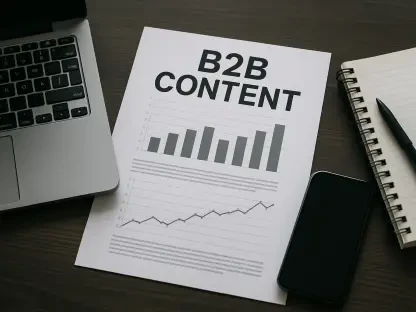Imagine launching a high-stakes marketing campaign, pouring resources into stunning visuals and heartfelt messaging, only to find that the analytics reveal a disconnect with the target audience. This scenario plays out far too often in the industry, where creative storytelling and data-driven marketing operate in silos, leaving campaigns falling short of their potential. The divide between emotional resonance and measurable outcomes has long been a challenge, but a powerful solution is at hand. Artificial Intelligence (AI) offers an unprecedented opportunity to unite these two critical elements, ensuring that campaigns not only inspire but also deliver tangible results. This guide explores how AI can bridge this gap, presenting best practices to align creative and analytical efforts for maximum impact.
Introduction to the Creative-Marketing Divide
Historically, the realms of creative storytelling and data-driven marketing have existed as parallel tracks within the campaign development process. Creative teams focus on crafting narratives that evoke emotion and build brand identity, while marketing teams prioritize metrics like click-through rates and conversion numbers. This separation often results in missed opportunities to optimize campaigns holistically, as qualitative aspects of content remain detached from quantitative performance indicators.
Bridging this divide is essential for enhancing overall campaign effectiveness and deepening audience engagement. When creative and analytical efforts are aligned, brands can deliver messages that resonate on a personal level while achieving measurable business goals. AI serves as a pivotal tool in this integration, enabling teams to analyze and refine content in ways previously unimaginable.
This guide delves into key areas where AI makes a difference, including its role in connecting creative and analytical teams, emerging trends in campaign optimization, practical applications of AI-driven strategies, and the future implications of this technology. By adopting these best practices, organizations can transform how they approach marketing, turning potential conflicts into collaborative successes.
Why Bridging the Gap with AI Matters
The integration of creative and marketing teams is not merely a nice-to-have but a fundamental requirement for achieving unified campaign objectives. When these groups work in isolation, the risk of misaligned messaging or wasted resources increases significantly. AI provides a framework to harmonize their efforts, ensuring that emotional storytelling is informed by performance data, resulting in campaigns that captivate and convert.
Using AI to merge these disciplines brings several tangible benefits. It enhances audience resonance by tailoring content based on real-time feedback, allows for swift mid-campaign adjustments to maximize impact, and delivers measurable outcomes that justify investment. Furthermore, AI-driven insights contribute to cost efficiency by optimizing resource allocation, preventing overspending on ineffective strategies, and providing a competitive edge in a crowded market.
Beyond immediate results, the strategic importance of AI lies in its ability to foster a data-informed culture across departments. By breaking down barriers between art and science, organizations can create a seamless workflow where every decision, from narrative tone to media placement, is grounded in evidence. This approach positions brands to adapt quickly to changing consumer preferences and market dynamics.
Key AI Strategies to Connect Creative and Analytical Efforts
AI-powered strategies offer actionable pathways to unite creative content with marketing performance, ensuring that campaigns are both inspiring and effective. These tools enable organizations to move beyond guesswork, providing data-backed insights that refine every aspect of a campaign. Below are detailed approaches to implementing AI, complete with practical steps and real-world applications.
Each strategy focuses on a specific aspect of integration, from real-time optimization to pre-launch testing and strategic differentiation. By adopting these practices, teams can create a cohesive process where creativity is enhanced by analytics, driving better outcomes. The following sections break down these methods, offering clear guidance for implementation.
Leveraging Real-Time Analysis for Creative Optimization
AI enables real-time analysis of creative assets by evaluating both qualitative elements, such as tone and messaging style, and quantitative metrics, including impressions and conversions. This dual approach allows marketers to gain a comprehensive understanding of how content performs as it rolls out. Platforms equipped with AI can process vast amounts of data instantly, providing actionable insights that were once only available after a campaign concluded.
The process of using AI for mid-campaign adjustments is straightforward yet powerful. By monitoring audience responses through social media sentiment, click patterns, and engagement rates, AI tools can suggest shifts in narrative style or visual elements to better align with preferences. For instance, if data shows a lack of emotional connection, teams can pivot to more heartfelt messaging without delay, ensuring the campaign remains relevant and impactful.
Case Study: Mid-Campaign Pivot Success
Consider a brand that launched a product campaign emphasizing logical benefits, such as cost savings, only to find lukewarm engagement. Using AI, the team detected this underperformance through real-time data analysis and shifted toward emotional appeals, highlighting personal stories of how the product improved lives. The result was a significant uptick in both engagement and conversion rates, demonstrating the value of AI in enabling agile, informed decision-making during active campaigns.
Utilizing Audience Simulation Models for Pre-Launch Testing
AI-driven audience simulation models provide a groundbreaking way to predict consumer responses to creative strategies before a campaign launches. These models analyze historical data, demographic trends, and behavioral patterns to simulate how different segments might react to specific messaging or visuals. This predictive capability reduces the risk of launching ineffective content, saving time and budget.
Implementing these models involves several key steps: first, inputting detailed audience profiles and campaign objectives into the AI system; second, testing multiple creative variations to assess potential outcomes; and third, refining the messaging focus, tone, or framing based on simulation results. This process ensures that the final campaign aligns closely with target audience expectations, maximizing its chances of success from the outset.
Example: Pre-Launch Strategy Refinement
A company preparing to launch a new service used AI simulations to test several creative approaches, ranging from humorous to serious tones. The data revealed that a sincere, solution-focused narrative resonated most with their intended audience. By selecting this strategy over others, the company avoided wasting budget on less effective concepts, ultimately achieving a higher return on investment upon launch.
Generating Metadata for Strategic Differentiation
Training large language models (LLMs) on brand-specific content allows for the creation of detailed metadata for creative assets, addressing critical questions about messaging focus and tone. This metadata provides a structured way to catalog and analyze content attributes, such as whether the narrative prioritizes education over urgency or adopts a humorous versus sincere style. Such insights enable teams to fine-tune their approach with precision.
Beyond internal analysis, AI can benchmark creative assets against competitor campaigns, identifying gaps and opportunities for differentiation. By understanding how rival brands position their messaging, organizations can craft unique emotional tones or value propositions that stand out in the market. This strategic use of metadata ensures that creative efforts not only engage audiences but also drive distinct business impact.
Real-World Application: Competitor Benchmarking
In one instance, a brand leveraged AI-generated metadata to analyze competitor messaging, uncovering an overemphasis on rational benefits across the industry. Armed with this insight, the brand adjusted its campaign to emphasize a deeply emotional tone, focusing on personal transformation. This differentiation captured audience attention in a saturated market, leading to increased brand recall and customer loyalty.
The Future of Performance Creative with AI
AI holds transformative potential in narrowing the divide between creative storytelling and marketing analytics, reshaping how campaigns are conceived and executed. As technology continues to evolve, its ability to integrate emotional depth with data precision becomes even more refined, promising a new era of performance creative. Brands that adopt these tools stand to gain a significant advantage in crafting messages that resonate and deliver.
For marketers looking to embrace AI, practical steps include fostering cross-functional collaboration between creative and analytical teams, ensuring that both perspectives inform decision-making. Embedding AI into existing workflows is also critical, as is investing in training to maximize the technology’s potential. Scalability, integration with current systems, and ongoing skill development are key considerations before full adoption.
Those who benefit most from this shift include brands seeking precision in campaign execution, agencies striving to balance art and science, and teams aiming for data-informed creativity. By aligning efforts through AI, these stakeholders can achieve a synergy that elevates both the emotional impact and measurable success of their work. The path forward lies in embracing this technology as a core component of marketing strategy.
In reflecting on the journey of integrating AI into marketing, it has proven to be a game-changer for uniting creative and analytical domains. The strategies employed, from real-time optimization to predictive simulations, have demonstrated remarkable potential in enhancing campaign outcomes. Moving ahead, the focus shifts to building robust systems for continuous learning, ensuring that teams adapt to emerging AI capabilities. Establishing stronger partnerships across departments becomes a priority, as does exploring innovative tools to further refine content precision. These steps pave the way for a marketing landscape where emotional storytelling and data-driven decisions coexist, driving sustained growth and impact.









